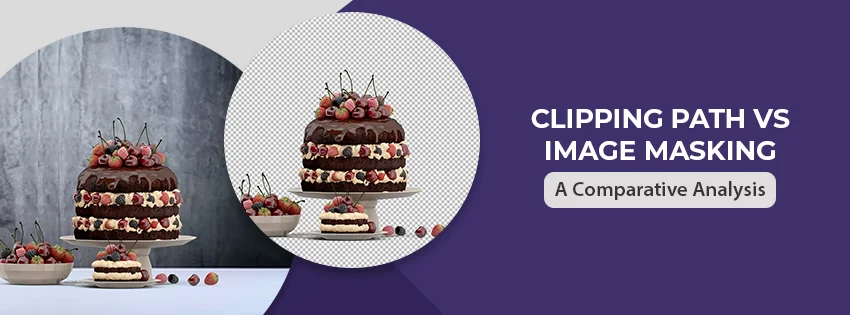This article is all about clipping path and image masking. We will discuss it in detail and make a comparative study to decide which one is the best.
Before starting, we need to know the basics of Photoshop, Clipping Path and Masking.
What is a clipping path in Photoshop?
The path of an object created with a pen tool, cut into the required shape using the clipping path. The image background altered as per the needs.
Clipping path is a time-consuming technique, but still, its accuracy makes it a go-to tool till date. It removes the background and allows the addition of suitable colors or shadows to the snap. The method works well for both hard and smooth edges. It requires years of practice to create perfect clipping paths. Flawed paths can dull the product image and the sales.
To achieve perfect results, the experts zoom into the photos till a clear edge view is achieved. Many eCommerce retailers use clipping path to make their products stand apart. In a nutshell, it is a process to remove background and replace it with another background.
There are different types of clipping path which can help with your work.
Adobe Photoshop: An Introduction
It is a graphics editor tool that helps you in image editing and retouching to create perfect photos. The file storage format is PSD by default, and it supports PSB and TIFF formats.
Overview of Tools in Photoshop
- Pen tool – used to create vector paths in clipping path.
- Freeform pen tool – helps to draw freehand paths.
- Magnetic pen tool – used to isolate paths from images.
- Clone stamp tool – used to duplicate an image or layer depending upon the need.
- Shape tools – It is a collection of geometrical shapes that you can use to draw vector graphics.
- Measuring and navigation tools
- Eye-dropper saves the sample colors for future use.
- Hand tool helps to move images.
- Zoom tools help in zooming in/out of an image.
- Cropping tool – helps to choose a particular area of an image or cut away the extra spaces.
- Slicing – helps to isolate the selected part of the image.
- Moving tool – helps to move the selected piece of the image to the desired location.
The above tool list helps to learn clipping path and image masking techniques without any hassle or confusion.
Types of Photoshop Clipping Paths
Multi-Layer clipping paths
When you create more paths on more layers in an image with the help of the pen tool, it is a multi-layer clipping path. It is a retouching technique used by companies that offer photo editing services.
Single-layer path
When you draw a simple path on the same layer with the help of a Photoshop pen tool, it is a single layer path. It is beneficial to remove or alter the background.
Illustrator path
The method helps to resize the photos without impacting the image resolution.
These methods have the following uses listed below:
Advantages of Clipping Path
Image Manipulation
With image manipulation, you can change or edit any part in an image, which is the purpose of the clipping path technique.
Image Background Removal
It is the prime use of image clipping, where the pen tool helps detect any hard edges in the image.
What is Image Masking?
It is also a background removal method, which is also known as layer masking. The technique helps to clear out the blurs and furry edges in apparel models or pet images.
It is near too impossible to do this type of hairy clearance with the clipping path technique. The layer masking uses a magic eraser and background eraser tool for the removal. It works well for images that have complex and many turns and curves too. In a nutshell, image masking segregates the images into layers or masks and makes them compliment the background.
The Photoshop software has different types of image masking functions that benefit the editing process.
Types of Image Masking
Advanced/Complex Layer Masking
This method helps you mask minute objects such as toy fur, pet hair, or a wavy hair model. With complex layer masking, you can isolate images and change backgrounds with ease. It is the most exciting feature that Adobe Photoshop can offer.
Photoshop Transparency Masking
For instance, when you need background removal for a glass product image, give this method a try.
Photoshop Collage Masking
When you want marketing collateral with flawless images, collage masking can deliver the desired results.
Translucent Image Masking
As the name suggests, it helps to segregate translucent objects in a product image. This type of masking removes the unwanted pixels to deliver perfect snaps.
Alpha Channel/Raster Masking
When you have a semi-translucent photo to edit, you can use this masking to get images with smooth edges. The professionals choose this method when it becomes challenging to create new layers.
As we are familiar with the clipping path and image masking, it is time to make some comparisons.
Difference between Photoshop Clipping Path and Image Masking
Destructive and Non-destructive
The clipping path uses a pen tool to draw a path around the objects, but the act is destructive. Once it is created and isolated, there is no point of return to the previous steps. It has anchor edit points, but still it is destructive.
But, with image masking, it is possible to go back to previous editing steps and recover details, so it is a non-destructive action. Also, you know that image masking can do this non-destructive action on complex images with ease.
Edges
The Photoshop clipping path technique works well on sharp and hard edges. But with image masking, the same process takes time and effort. So, the final results from image masking will not meet your expectations.
In case the image has smooth edges, then image masking works well. There will be a loss of details with the clipping path method, where you have to again move towards masking.
In simple terms, you can use both the methods depending upon the edges of the image.
Compatibility
When the image has soft and hard edges, you can use the clipping path for hard edges and masking for smooth edges. It means that the image is compatible with both techniques. You have to do the clipping path first and the masking process later. But when done in reverse, it is a waste of your resources. Choosing a suitable process needs some expertise.
Hardness and Smoothness
Clipping path uses sharp vector paths, and so it gives sharp edges to the images ensuring good looks. When the photos have smooth edges, masking is a better idea to get the desired result.
Images contain hard and thin edges, and so depending on the subject, it is better to adapt to both the processes. They both have some significant features which you cannot ignore.
Time consumption
Time is precious and crucial for those involved in the photo editing process. Analyze the edges, texture, and background color, and then choose clipping or masking. When the image needs clipping, go with it, and don’t do masking. If there is a need for both the processes, do the clipping first and masking later.
The best way to get started is to get familiarized with both the techniques beforehand. Both the techniques have unique functionalities that one cannot ignore. Practice makes a man perfect and clever. There are no short-cut methods to success in this domain, and the only way is to learn, apply, and repeat.
Which is better of the two? It depends upon the company that offers clipping path services.




